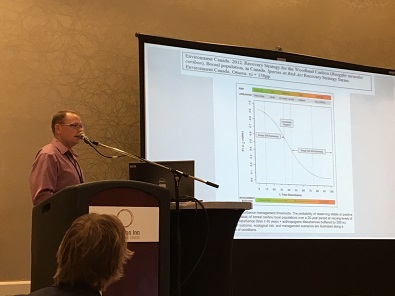Philip McLoughlin speaking at an SMA environmental forum in Saskatoon. Photo by Joel Willick.
New research out of the University of Saskatchewan has found the boreal forest woodland caribou population in northern Saskatchewan is doing rather well.
Researchers spent the past three years tracking the caribou herds in the northern boreal forest, as well as the movement of wolves and black bears.
The research shows a healthy and sustaining caribou population.
“The caribou population right now, as far as we can tell, is what I would describe as stable to slightly increasing,” says lead researcher and Biology Professor Philip McLoughlin. “It is a high density caribou population, actually one of the highest densities of boreal caribou in Canada.”
The research entitled, “Population dynamics and critical habitat of woodland caribou in the Saskatchewan Boreal Shield,” has not yet been published. However, it shows a caribou population in the region of 36.9 caribou/1000 square km. According to McLoughlin, this is high for caribou and roughly twice the density as found in Alberta.
McLoughlin says based on the evidence, the northern Saskatchewan boreal shield may be the most secure of all boreal caribou populations in Canada. He says there are several factors that have led to such a pristine situation.
“It’s a natural area with very low levels of human impact in terms of roads, trails and hunting,” says McLoughlin.
Other factors like predators and forest fires are lower in the region, as well helping lead to the growing caribou numbers.
According to McLoughlin, the research is vital because it covers an area where data had been previously lacking.
“The research is filling the gap in terms of what we know about this caribou range and how it fits into the Canadian picture of boreal caribou populations,” he says.
The research is expected to be released to the public in November. McLoughlin was presenting his findings to a Saskatchewan Mining Association Environmental Forum earlier this week.
